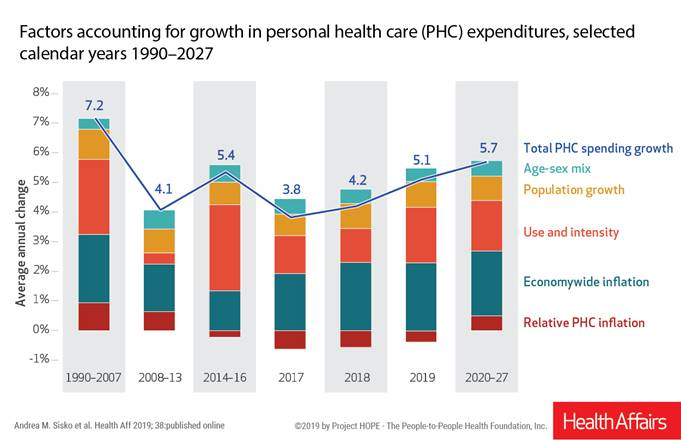 National health spending in the U.S. is expected to grow by 5.7% every year from 2020 to 2027, the actuaries at the Centers for Medicare and Medicaid Services forecast in their report, National Health Expenditure Projections, 2018-2927: Economic And Demographic Trends Drive Spending And Enrollment Growth, published yesterday by Health Affairs.
National health spending in the U.S. is expected to grow by 5.7% every year from 2020 to 2027, the actuaries at the Centers for Medicare and Medicaid Services forecast in their report, National Health Expenditure Projections, 2018-2927: Economic And Demographic Trends Drive Spending And Enrollment Growth, published yesterday by Health Affairs.
For context, note that general price inflation in the U.S. was 1.6% for the 12 months ending January 2019 according to the U.S. Bureau of Labor Statistics.
This growth rate for health care costs exceeds every period measured since the high of 7.2% recorded in 1990-2007.
The bar chart illustrates the factors contributing to growth in personal health care spending. The largest components are expected to be economy-wide inflation, utilization, and population growth.
Underneath this macro trend are some important trends to call out. A key headline is that there will be a shift expected from the commercially insured population to Medicare, as more Baby Boomers move from working health citizens to aging into Medicare. For these enrollees, increases in fee-for-service hospital care and prescription drugs will push spending upward.
In addition, five States are expected to expand Medicaid in the next couple of years, moving more people into these State-specific health insurance plans in Idaho, Maine, Nebraska, Utah and Virginia. (These are the known-knowns of Medicaid expansion at the time CMS published this forecast).
The cost driver of “use and intensity” responds to these covered populations and people gain access to insurance and, therefore, services. The share of health care spending sponsored/financed by Federal, State and local governments will grow to 2027, reaching 47%. Thus, by 2027, health spending will be roughly split by public and private sector sources of payment.
Growth in prescription drug spending is another area to watch in this forecast, and others we track on Health Populi. CMS expects Rx drug spending to increase by 6.1% year on year to 2027, accelerated growth due to aging of the population and new more expensive drugs expected to come onto the market to treat cancer, diabetes, and Alzheimer’s disease, among other treatments. (For more on specialty drug cost growth, see this post in Health Populi).
Keep in mind the methodology of this annual forecast: CMS actuaries do not anticipate or design in sensitivity analysis for any changes to workflow, plan design (like value-based bundled payments), or consumer behavior change. Market-based wild cards, such as consumers’ conducting more medical visits via lower-cost telehealth channels (to lower costs), or growing adoption of financial support for high-cost medicines (such as Bluebird Therapeutics’ vision to charge a patient based on an installment plan and outcomes over a course of years using a therapy) could move these numbers up or down.
Health Populi’s Hot Points: By 2027, $1 in every $5 of the GDP will be spent on health care in America. The aging of America, combined with very expensive novel treatments coming on stream to deal with both chronic condition epidemics like diabetes and heart disease, and to treat complex conditions like Parkinson’s, Alzheimer’s, HIV/AIDS, and once-untreatable cancers.
Most Americans are coming to embrace and expect health care as a civil right through some form of universal health insurance in the U.S. Many of the candidates who have come forward to run as Democratic candidates for President support some flavor of Medicare for All, one of many possible designs for universal health care in America.
As Medicare enrollment organically grows based on current demographics in the nation, the health plan will be challenged to meet its fiscal obligations based just on its current actuarial expectations. The 19.4% GDP share for health care expected in 2027 based on CMS’s current projections of the current state would shift well above 20% were Americans, say over 50 years of age, allowed to buy into Medicare as envisioned by some of the Presidential candidates’ platforms for health care reform.
We’ll continue to track the growing embrace of universal health care tempered by the health economic and macroeconomic realities in the coming months leading up to the 2020 U.S. Presidential Election. Many grassroots health care issues will play into this discussion, from the cost of EpiPen for middle-class families, to access for specialty drugs that treat a child’s leukemia (running over $500,000 for CAR-T therapy, as an example) to a senior’s need for a ride to a medical appointment — falling into the crucial bucket of social determinants that bolster public and individual health.
For now, the sobering state of affairs is that in America, health care costs continue to increase faster than the rest of the economy, and economic growth overall.
The post National Health Spending Will Reach Nearly 20% of U.S. GDP By 2027 appeared first on HealthPopuli.com.
National Health Spending Will Reach Nearly 20% of U.S. GDP By 2027 posted first on http://dentistfortworth.blogspot.com
No comments:
Post a Comment